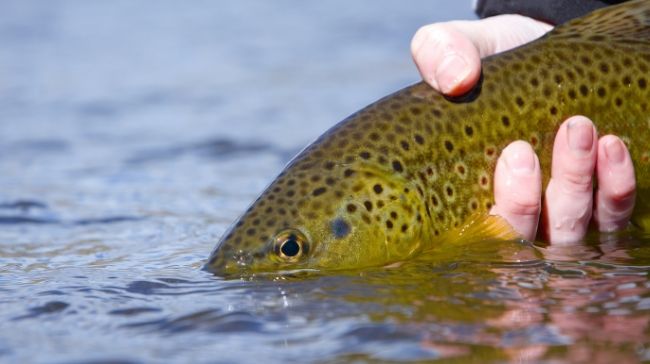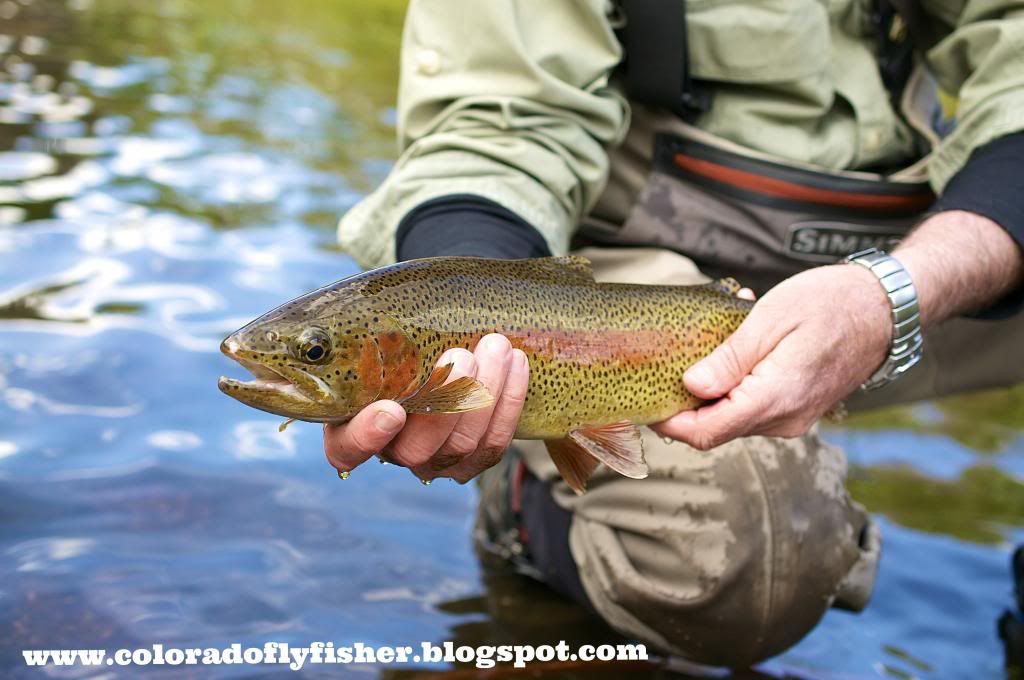When I think of tailwater fly fishing I picture rocky canyons, big fish, small flies and cold winters. A tailwater is anywhere a river comes out beneath a bottom-release dam. Rivers like the South Platte can have several lakes or reservoirs along its drainage, all of which can provide very different fly fishing experiences.
| Photo by Jon Kleis |
Good winter patterns are: Kleis's Mid-Drift Midge size 22, gray RS-2s size 22-24, Dorsey's Top Secret midge size 22-24, Black Beauties size 22-26, Parachute Adams size 24-26, Apricot Glow Bugs size 16, San Juan worms size 16, and for some tailwaters, Mysis Shrimp patterns like Sand's Epoxy Mysis size's 16-18.
 |
| Kleis's Mid-Drift Midge in Olive |
Tailwaters also provide great fishing opportunities in the summer months, and in states that normally would'nt have water cold enough to hold trout. During the summer, water at the bottom of these reservoirs stays cooler because of the lack of exposure to sunlight. Rest assured, if there is a bottom-release reservoir -even in states as hot as Texas- the odds are good that at least part of the year the river below holds trout.
As far as insects go, the bugs that can be found are as diverse as the types of tailwaters they live in. Even during winter there are more than just midges and baetis available. There are also stonefly nymphs, caddis larvae, annelids, crane fly larvae, leeches, and terrestrials such as scuds and crawfish. Baetis, midges, and small stoneflies are typically the only two insects that are comfortable hatching in temps associated with winter fishing, so that is what the trout focus on. Stonefly nymphs don't go through an emergence stage like a mayfly nymph, so unless there are a ton of stonefly nymphs on the move, trout might not be conditioned to seeing and eating them. Trout have to see the bug in order to eat the bug. Try using a small stonefly pattern as your lead fly on a 2 fly nymph rig, but if you see it spooking trout, or that it's not producing, switch to 22's-26's.
 |
| Stonefly found during winter photo by Jon Kleis |
In the spring fish are looking up for caddis and baetis that are either emerging, or resting on the surface as adults. Fish also move into shallower and faster feeding lanes as a result of run-off, and the rainbow/cutthroat spawn.
Avoid casting to fish that you can tell are actively spawning on a gravel bed. Instead, target the back of spawning beds in an attempt to pick up fish that are feeding on eggs. Because trout spawn, or stage in shallow and well oxygenated water, my strike indicator is set shallow so I don't drag on the bottom. This increases my chances of detecting a strike sooner, and reduces my chances of foul hooking fish.
You will know after a few casts if a fish is feeding, or has something else on its mind. Land the fish as quickly as possible and handle the fish as little as possible. Always keep the fish and the net in the water after landing your catch. Another great way to fish the spawn is to find fish as they migrate. Migrating fish are eager takers and are still exposed in fast, and shallow water.
Starting in late-spring/early-summer a good all around PMD nymph imitation to use is the Pheasant Tail nymph. A good way to fish when trout aren't actively feeding on the surface is to use a tandem nymph rig under a strike indicator. I like to use a Pheasant Tail as my first fly, and with 5x tippet tie about a 15 inch section of leader material from the bend of the Pheasant Tail hook to a size 22 or smaller gray RS-2. Roughly 8-10 inches in front of the Pheasant Tail clamp a #1 or #4 split shot to help your flies get down.
Adjust your indicator according to the depth of the water your fishing in, so you're presenting your flies to the fish in their feeding zone where they can see it. Now you're covering two bases (PMDs and BWOs) which doubles your odds of fooling different fish that could be focusing on two completely different hatches. Make sure to check with your states regulations before you fish tandem rigs because its illegal in some states.
Tailwaters are so loaded with bugs and nutrients trout can grow up to 2-6 inches per year depending on the amount of fishing pressure, size of the river, and how much protein-rich food they have access to. Some rivers have an abundance of shrimp such as the Mysis or Scud Shrimp and when trout key in on these two freshwater crustaceans they grow even faster, and have the most amazingly vibrant colors found on trout anywhere in the world.
Huge trout and scenery like this are what keeps most anglers coming back to these fisheries. If I had to choose one type of water to spend my entire life fishing, forsaking all others, it would be a tailwater. This is a place where you can challenge yourself to become a better angler, and have a chance to land the fish of a lifetime. To request a guided trip with me on the South Platte shoot me an email to jonkleisflyfishing@yahoo.com
 |
| Photo by Daniel Zimmerman |
Early Summer means fish are now looking up for sparse caddis hatches along with stoneflies such as the Yellow Sally Stonefly, as well as emerging and adult PMDs. Good dry fly imitations for stonefly hatches are the Headlight Yellow Sally, and Stimulators. Fish are also looking for terrestrials like hoppers, ants, and beatles. As far as nymphs are concerned, try a Lafontaine's Sparkle Pupa behind a tan-colored San Juan worm. Late summer signals the start of the Trico mayfly hatch in many tailwaters. Depending on the river and it's biomass, the trico hatch itself can be huge, and trout feed like ravenous sharks as the bugs die and fall to the water in what's called a "spinner fall."
Late summer and fall is by far my favorite time of year to fish. In the morning, anglers are casting small trico dry flies. Midday, have on some form of bouyant hopper with a drowned trico or small black RS-2 as a dropper. During the afternoon/evening, caddis and sparse baetis hatches are back on the menu. In my humble opinion, outside of the Mother's Day Caddis hatch, fall is the best time of year to fish with dry flies.
 |
As the water cools and the days shorten, brown trout are staging to spawn, making them accessible to anglers. Land-locked Sockeye salmon called Kokanee start their spawning migration, also. Egg patterns, Copper Johns, and small olive baetis droppers are great flies to use in tandem if you decide to fish close to the bottom.
Tailwaters are so loaded with bugs and nutrients trout can grow up to 2-6 inches per year depending on the amount of fishing pressure, size of the river, and how much protein-rich food they have access to. Some rivers have an abundance of shrimp such as the Mysis or Scud Shrimp and when trout key in on these two freshwater crustaceans they grow even faster, and have the most amazingly vibrant colors found on trout anywhere in the world.
 |
| Elevenmile Canyon photo by Daniel Zimmerman |



Float fishing is one of many techniques used to catch trout. It's primary used in rivers in and streams where there's a little current to help carry the float downstream.best fish finder
ReplyDelete